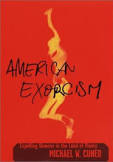Unsolved:American Exorcism
 | |
| Author | Michael W. Cuneo |
|---|---|
| Publisher | Doubleday (publisher) |
Publication date | 2001 |
| ISBN | ISBN:9780385501767 |
American Exorcism: Expelling Demons in the Land of the Plenty is a 2001 book written by Michael Cuneo and published originally by Doubleday. It follows the experience of Cuneo while he toured the United States of America and witnessed over 50 exorcisms.[1]
Summary
American Exorcism discusses the history and popular culture representation of exorcism in the United States, juxtaposed with Cuneo's experience attending over 50 exorcisms in person. Through his research, Cuneo highlights important figures, such as Malachi Martin, Frank and Ida B. Hammond, and Peter Blatty, as well topics such as the difference between Catholic exorcism and Deliverance ministry. This text discusses the meteoric rise of exorcisms in the United States, especially alongside other technological advancements. Mark Dery, writing for The Washington Post , explained that
Cuneo reads the phenomenon as a backlash by religious conservatives, adrift in a secular society that they perceive as amoral, while at the same time feeling alienated from an increasingly secularized Protestantism or a post-Vatican-II Catholicism. To him, the charismatic ministers and renegade priests are casting out the demons of social change: feminism, the sexual revolution, New Age spirituality and the loss of faith in traditional institutions.[2]
Reception
Kirkus Reviews called American Exorcism "an engaging and detailed document of a provocative subculture [...] that will neither confirm nor confound the reader’s demonic fears".[3]
Publishers Weekly referred to the book as "mesmerizing", noting that the book is "lucidly written and riveting as any horror novel". They concluded that "Cuneo's excursion into the darker paths of American faith offers a deeply disturbing, ironic vision of what he sees as the unintended consequences of popular culture for the modern religious imagination."[4]
Mark Dery, writing for The Washington Post , noted that the book is "armed with a wry wit and girded in the armor of an inquiring but 'open-mindedly skeptical' intellect".[2]
Booklist also reviewed the book.[5]
References
- ↑ Cuneo, Michael W. (2001). American exorcism: expelling demons in the land of plenty. New York, NY: Doubleday. ISBN 978-0-385-50176-7.
- ↑ 2.0 2.1 Dery, Mark (2001-09-16). "The Possessed" (in en-US). The Washington Post. ISSN 0190-8286. https://www.washingtonpost.com/archive/entertainment/books/2001/09/16/the-possessed/b242b000-eece-4c75-a71d-d185651432cc/.
- ↑ "American Exorcism". 2001-06-15. https://www.kirkusreviews.com/book-reviews/michael-w-cuneo/american-exorcism/.
- ↑ "AMERICAN EXORCISM: Expelling Demons in the Land of Plenty by Michael W. Cuneo". 2001-07-02. https://www.publishersweekly.com/9780385501767.
- ↑ "American Exorcism". July 2001. https://www.booklistonline.com/American-Exorcism-Expelling-Demons-in-the-Land-of-Plenty-Michael-W-Cuneo/pid=1099101.
Further reading
- Dziuba, Andrzej F. (2007). "Michael W. Cuneo, American Exorcism. Expelling Demons in the Land of Plenty. Doubleday. New York, London, Toronto, Sydney, Auckland 2001, ss. 314." (in pl). Saeculum Christianum: Pismo historyczno-społeczne 14 (1): 331–336. https://bazhum.muzhp.pl/media/files/Saeculum_Christianum_pismo_historyczne/Saeculum_Christianum_pismo_historyczne-r2007-t14-n1/Saeculum_Christianum_pismo_historyczne-r2007-t14-n1-s331-336/Saeculum_Christianum_pismo_historyczne-r2007-t14-n1-s331-336.pdf.
- Gunn, Joshua (2002). Cuneo, Michael W.; Medway, Gareth J.; Ellis, Bill. eds. "Lucifer Rising (Yet Again)". Rhetoric Society Quarterly 32 (4): 105–111. doi:10.1080/02773940209391242. ISSN 0277-3945. https://www.jstor.org/stable/3886022.
 |

